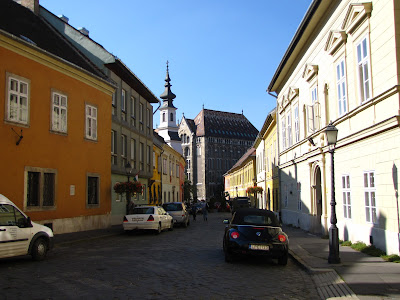
Our train ride to Belgrade from Budapest was filled with card-playing, beautiful scenery and a comical border crossing into Serbia. Our first passport check in Hungary was quite thorough with each immigration officer carrying a wireless passport scanner. Our second passport check on the Serbian side consisted of “good day and thank you” with barely a glance at your passport. M has not been back to Serbia in 10 years due to mandatory military service, yet if he had known how easy it was to pass the Serbian passport control by train he would have been back a long time ago.
So now, M is finally home after 10 long years. S was there last year so it was so same old for her .. Kidding J . Of our 19 days in Serbia, 10 were spent in the capital, Belgrade. And would you believe it that in those 10 days, we spent a total of 6 hours walking around the city … if that much.. I know, crazy. The rest of our time was spent …. Come on guess … EATING and drinking coffee. So, while we can’t show you too many pictures of this beautiful city, we can tell you, that we had a wonderful time with our family and friends, and wouldn’t trade it in for the world.

Now we did see some things, though we wish we had taken a few more pictures for this post but, we’ll work with what we have. Belgrade has gone through a lot in its history. It has been torn down and rebuilt countless times, starting from the Romans, to the Ottoman Empire, two world wars (during WWII it was bombed by both the Allies and the Nazis) and let’s not forget 10 years of civil war and the 1999 NATO bombing. All of this had an effect on the city either physically or financially. However, through all this hardship, Belgrade is re-emerging, and rebuilding itself back to the world class city that it was in the ‘80’s.
 |
| sunset looking down from Kalemegdan's Pobednik (The Victor) |
The Danube and the Sava river flow through Belgrade, dividing the city in two: old and new Belgrade. At the confluence of the Sava river into the Danube sits the Kalemegdan fortress, which is the oldest section of urban Belgrade and dates back to the 3
rd century BC (when Serbs were eating with forks and knives and the rest of you savages were eating with your hands
J ). No seriously, it is a beautiful place to walk around and one we made sure to visit. The grounds consist of cafes and restaurants, tennis courts (where the moats used to be - quite cool), basketball courts, an old church and plenty of green space. They also have art exhibits on the boardwalk overlooking the water and the best sunsets in Belgrade. When you exit Kalemegdan you end up at the beginning of Belgrade’s pedestrian shopping street, Knez Mihailova Street.
 |
| Hram Svetog Save (Cathedral of Saint Sava) |
Belgrade also has the largest Orthodox cathedral in the world: Hram Svetog Save (Cathedral of Saint Sava - who was the founder of the Serbian Orthodox Church). The Hram sits on the Vracar Plateau on the location where Saint Sava’s remains were burned in 1595 by the Ottoman Empire. From this location the Hram can be seen from almost anywhere in Belgrade and is a great orientation point. The construction of the Cathedral began in 1935 and it’s interior is still under construction (the constructoin of the church is being financed solely by donations) while the exterior and surrounding park is 95% complete.

Last but not least is Belgrade’s night life, and what a life it is. Serbs really know how to celebrate and party.
Belgrade is said to be the party capital of Europe and we certainly understand (and felt) why. To experience its night life you have many options to choose from: bars, restaurants, nightclubs, kafana’s (typical Serbian restaurant playing live Serbian music until the wee hours of the morning which we had the pleasure … and pain the next day … of experiencing) and splavovi (barges on the Sava and the Danube). One definitely must go out to either a kafana or a splav (though we’d recommend both) when visiting Belgrade. They should be considered one of the top 100 things you do before you die. It’s impossible to describe the amazing atmosphere and depth of celebration/energy at a Serbian kafana … everyone is singing and dancing around with the Serbian band and trubaci (brass band). Just amazing. But watch out for the rakija (moonshine made of fruit such as plums, pears, apple and our chosen one was quince) - while delicious this brandy can be deadly.
 |
| Splavovi (typical Belgrade barges) |
 |
Kafana Galeb in Zemun (Belgrade)
confluance of the river Sava into the Denube
Pobednik ("The Victor" overlooking the two rivers)
Kalemegdan
Kalemegdan
St. Sava Cathedral (Hram Svetog Save)
|

















































